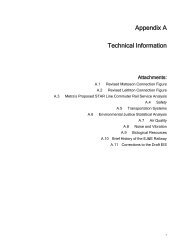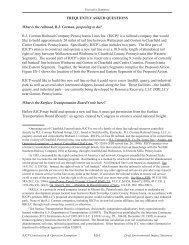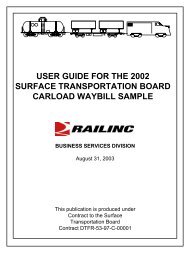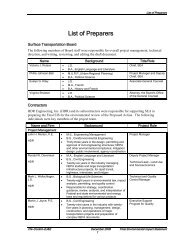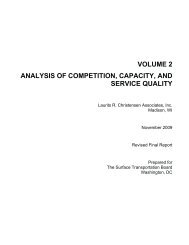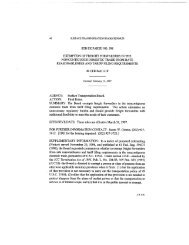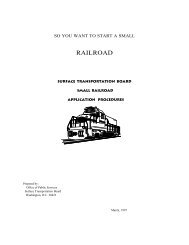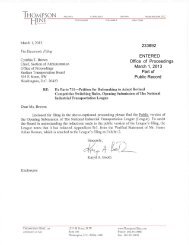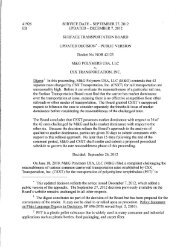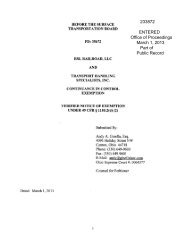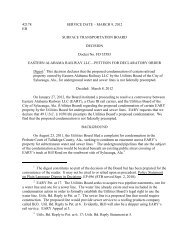Norfolk Southern/Conrail Rail ConnectionâBucyrus, Ohio - Surface ...
Norfolk Southern/Conrail Rail ConnectionâBucyrus, Ohio - Surface ...
Norfolk Southern/Conrail Rail ConnectionâBucyrus, Ohio - Surface ...
Create successful ePaper yourself
Turn your PDF publications into a flip-book with our unique Google optimized e-Paper software.
STB Finance Docket No. 33388<br />
NOISE LEVEL THRESHOLDS<br />
The STB regulations specify that noise studies be done for all connections where traffic will increase<br />
by at least 100% as measured by annual gross tons miles or at least 8 trains per day.<br />
The noise increase is to be quantified for all sensitive receptors (schools, libraries, residences, retirement<br />
communities and nursing homes) that are in the project area where these thresholds will be surpassed.<br />
The Day-Night Sound Level, abbreviated L or DNL, represents an energy average of the A-weighted<br />
dn<br />
noise levels occurring during a complete 24-hour period. An increase in L of 3 dBA could result from<br />
dn<br />
a 100 percent increase in rail traffic, a substantial change in operating conditions, changed equipment,<br />
or a shift of daytime operations to the nighttime hours. Nighttime noise often dominates L because<br />
dn<br />
of a weighting factor added to nighttime noise to reflect most people being more sensitive to nighttime<br />
noise. In calculating L , the nighttime adjustment makes one event, such as a freight train passby,<br />
dn<br />
occurring between 10 p.m. and 7 a.m., equivalent to ten of the same events during the daytime hours.<br />
There are some track segments where the STB threshold for a noise study is exceeded, but the total<br />
change in noise exposure would be insignificant. The approach taken was to analyze those areas where<br />
the projected increase in train volume or change in train mix would be expected to cause: (1) more than<br />
a marginal change in noise exposure, and (2) cause a significant increase in the number of noise<br />
sensitive receptors within the L dn 65 contour. For this study, any increase in L dn less than 2 dBA was<br />
considered insignificant. A 2 dBA threshold was selected because:<br />
1. Near railroad facilities, a plus or minus 2 dBA variation in L is common because of the normal<br />
dn<br />
variation in factors such as: operating condition, operating procedures, weather, time of day, and<br />
equipment maintenance.<br />
2. In most cases, a 2 dBA increase in noise exposure would cause only a small change<br />
(approximately 10%) in the number of residences within the L dn 65 contour. This is because<br />
noise impacts from train operations tend to be localized to the residences closest to the tracks.<br />
The acoustic shielding provided by the first row or two of residences is usually sufficient to keep<br />
noise exposure below L dn 65 at residences that are farther away.<br />
3. Although a 2 dBA increase in noise exposure is often considered an insignificant change, it was<br />
selected as a conservative screening level for this study and for previous studies.<br />
Approach<br />
The overall goal of the noise study is to identify noise sensitive land uses where the projected change<br />
in operations could result in noise exposure increases that meet or exceed the STB thresholds. This<br />
assessment provides estimates of the number of noise-sensitive receptors where there will be a significant<br />
increase in noise exposure and the STB thresholds will be exceeded.<br />
Following is an outline of the approach that has been used for the assessment of potential noise impacts:<br />
1. Develop noise models: Models for estimating rail line noise have been defined for significant<br />
noise sources. For connections, the dominant noise sources are the normal noise from freight<br />
and passenger train operations and the audible warning signals at grade crossings. Curves with<br />
small enough radii for substantial wheel squeal are normally lubricated to control wear and<br />
noise.<br />
2. Identify sensitive receptors and existing noise conditions: Noise sensitive land uses were<br />
identified through review of USGS maps, aerial photographs and site visits.<br />
3. Project existing and future noise exposure: Information on distances and propagation paths to<br />
sensitive receptors and existing and future operation plans have been used to estimate noise<br />
exposure in terms of the L dn. Instead of doing noise projections for each sensitive receptor, Ldn<br />
65 contours were drawn on the maps or aerial photographs. For all of the rail segment noise<br />
projections, the average train was assumed to be 5000 feet long.<br />
D-22




